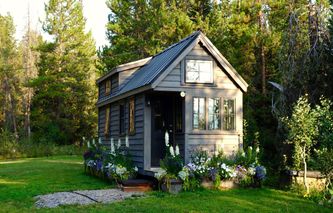Details Last Updated: Tuesday, 06 October 2020
They're referred to as trailer homes, mobile homes, manufactured housing, and modular homes. The common thread is this: these structures are prefabricated. All or a portion of the home is manufactured elsewhere and transported to a site selected by the buyer.
Demand for Prefabricated Homes
There is a robust market for prefabricated homes. In the United States, recent estimates indicate that over 94,600 housing units are sold annually. Shipments are expected to continue to rise at a 2% annual pace, and sales were over $9 billion in 2019.
Additional Resources |
But aren't these the same homes that are always destroyed in major storms, hurricanes, and tornadoes? To an extent that is true, if it's a prefabricated home built before 1975. However, the homes built today are manufactured to completely different quality and structural standards.
In the next several paragraphs we'll explain where the manufactured home industry was back in the 1950s and where it is today. Later on, we'll talk about some of the special considerations consumers of these homes need to think about before buying a home. We'll finish up by introducing some online tools that can help shoppers compare mortgages and calculate their expected monthly mortgage payments.
History of Prefabricated Homes
Today's prefabricated homes had their humble beginnings as the simple house trailer, which was developed after WWII and designed to be pulled behind a motorized vehicles such as a car. These house trailers were remarkably durable, and many are still in use today as homes, long after their road-worthy days were over.
Mobile Homes
In the 1950's, these house trailers morphed into larger mobile homes, which could still be towed by a motorized vehicle; although by now they needed a special truck to move them around. The marketplace was extremely competitive, and companies attempted to gain a larger market share by lowering their prices. Quality standards began to suffer, and these homes became a cheap way for many Americans to own a house.
Prefabricated Homes
State officials soon realized that if these prefabricated structures were going to be used as a permanent residence they also needed to comply with state and local safety standards. Since safety standards could be different from state to state, this presented a problem for prefabricated home manufacturers.
The economic benefits of mass production, would be lost if a home had to be custom made to each buyer's home state's regulations. Thankfully, the federal government took the lead, and in 1976 the U.S. Department of Housing and Urban Development (HUD) began to publish a set of building standards for prefabricated homes. These standards greatly improved the overall quality of the homes being built; however, the standards were so challenging that sales dropped dramatically in the mid to late 1970s.
In addition to infrastructure safety, homeowners need to consider the safety of the house itself. According to burglary statistics "burglary is one of the most common crimes in the world and a big worry for homeowners".
Revival of the Prefabricated Home
In 1994, the HUD building code was updated to include even higher standards for a manufactured home's thermal insulation and wind resistance. Regulations now include design and construction, strength and durability, transportability, fire resistance and energy efficiency. While these quality standards would drive the cost to produce a prefabricated home higher; the consumer was now living in a much safer and stronger home.
The industry today has evolved quite a bit from its trailer home beginnings. The industry also goes to great lengths to emphasize the differences between today's homes built to HUD's quality building code, and the homes built prior to the 1970's.
Prefabricated home manufacturers today offer a true "turn-key" approach to buying a home. They can help buyers to find a location for the home, offer a variety of design options, and even provide financing such as access to mortgages.
Buying a Prefabricated Home
Fortunately, we have several articles that can help shoppers through the process of buying a prefabricated home. A prefabricated home will be built at the manufacturer's plant and transported to its final destination. The transportation of the home presents the buyer with some very serious logistical problems; the utmost being getting the home there in one piece.
Anyone that's interested in learning more about this process can take a look at our article entitled: Buying a Manufactured Home. That article discusses topics such as:
Manufacturer Warranties: including what to look for in a new home warranty such as length of coverage, items covered, and the claims filing process.
Site Selection: how to figure out where the home can be located.
Building / Zoning Boards: working with local officials to make sure the home meets local standards.
Site Preparation: making sure the chosen location is ready to receive the home.
Transportation: the special transportation considerations that need to be thought through before buying a home.
Home Installation: ensuring the foundation or slab is prepared properly to have a home securely attached.
Financing a Home
Finally, we have some online mortgage calculators that can help buyers that are considering purchasing a prefabricated home figure out what they can afford to pay, including:
Maximum Mortgage Calculator: can help figure out how large a home loan a buyer can afford by examining their household income and existing debt.
Simple Monthly Mortgage Calculator: a great tool for buyers that only want to see how much a loan is going to cost each month.
Mortgage Comparison Calculator: a good resource for anyone that's been shopping around for a mortgage, and wants to compare offers.
Mortgage Points Calculator: allows users to figure out if paying mortgage points is worth the expense.
About the Author - Prefabricated Homes

.jpg)

